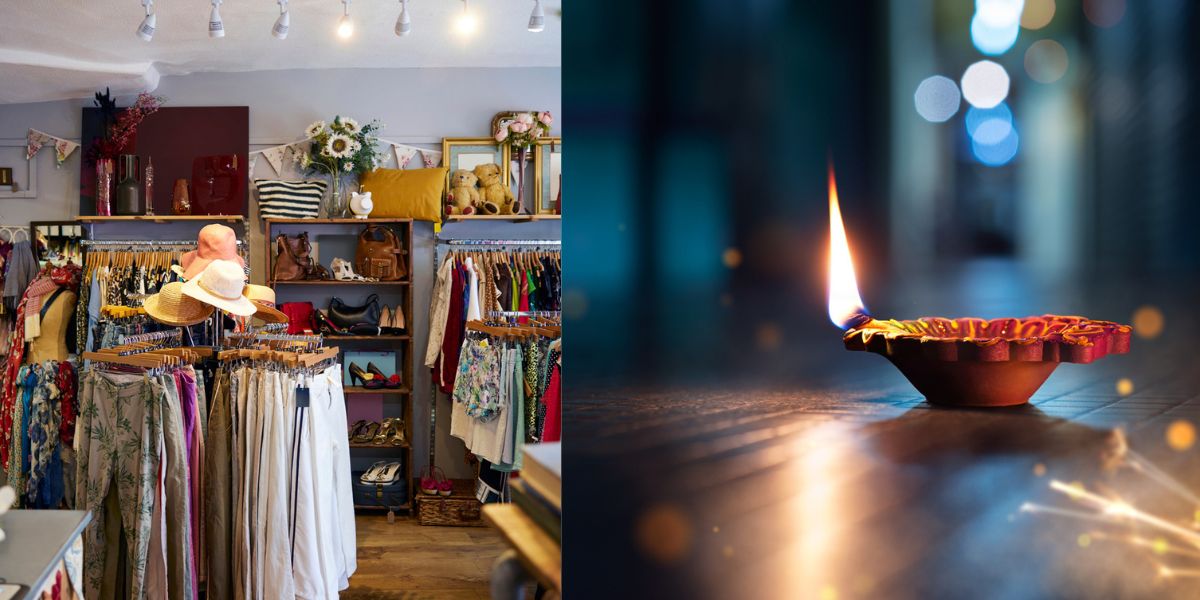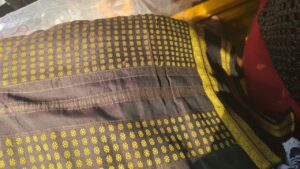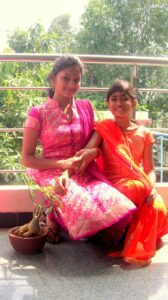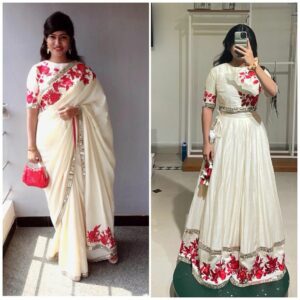From the evolution of festival attire traditions to embracing thrifting and repurposing memories, Chennai locals prioritise sustainability in the face of growing textile waste.

According to the 'Wealth in Waste' report by Fashion for Good, India accumulates up to 7,800 kilotonnes of textile waste annually. (Supplied)
For those who grew up celebrating Deepavali, one cannot ignore the significance attached to buying new clothes for the festivities.
“In the past, the joy of obtaining new clothes for festivals was heightened by their rarity. Occasions like Pongal, Vinayakar Chathurthi, and the grand celebration of Deepavali were exclusive times for such purchases, bringing a sense of excitement. These festivals meant anticipating the joy of donning something new,” shares Amuthasanthi, a nurse.
However, in the present day, it has become a routine. The ease of browsing and purchasing with a simple click has transformed it into a daily activity.
“Occasional visits to malls now involve casually selecting garments based on personal preferences for many. The once-exceptional experience has become a commonplace occurrence. Even my 13-year-old isn’t interested in buying new clothes for festivals anymore,” shares Amutha, who won’t be adding anything new to her wardrobe this year.
While concerns may arise about the “tradition” losing its novelty, there’s a more pressing issue to consider.
According to the ‘Wealth in Waste’ report by Fashion for Good, India accumulates up to 7,800 kilotonnes of textile waste annually.
The largest share, approximately 51 per cent, originates from Indian consumers.
Amid the ongoing efforts by sustainability leaders to tackle this issue head-on and the global community exploring ways to minimise textile waste, residents of Chennai are actively contributing to reducing their environmental impact, it seems.
This Deepavali, some have chosen to engage in thrifting, swapping, and recycling pre-loved goods as part of their commitment to sustainability.
For Arya Rajam, a novelist, sustainability is a way of life.
“For many years now, I have been living a green, eco-conscious and minimal life,” she shares.
The inspiration for her eco-conscious journey ignited when a child in her neighbourhood shared insights about composting, landfills, and the detrimental impact of waste on the environment.
Ever since that moment, she has been driven to live a plastic-free life, embracing a commitment to environmental responsibility.

Arya’s Deepavali green lehenga is from The Relove Closet, a thrift store marketplace. (Supplied)
“I wanted to challenge the traditional approach to shopping. Instead of indulging in the cycle of buying expensive clothes that end up in landfills after a few uses, I opt for sustainable practices like thrifting. It not only adds unique pieces to my wardrobe but also contributes to keeping clothes out of landfills,” shares Arya, who consciously limits her overall shopping and prefers sustainability over the lure of new labels.
Recently, for Deepavali, she found a beautiful green lehenga from The Relove Closet, a thrift store marketplace by Sruti Ashok. “I don’t shop specifically for festive clothes, as my mom has an extensive saree collection. When I do need something for a festive occasion, I turn to thrifting on designated days,” she shares.
Thirupurasundari Sevvel, an architect and the founder of Nam Veedu Nam Oor Nam Kadhai, learned about thrifting and swapping while spending time in the UK and France.

Thirupurasundari’s Deepavali saree, thrifted from India Wasted. (Supplied)
Now in Chennai, she swaps toys, clothes, and accessories. “I was also introduced to a thrift store called Rebirth Collective by India Wasted and shopped there last Pongal and this Deepavali. This place has been my go-to. I ensure I recommend it to anyone who asks me for an interesting experience in Chennai,” she shares.
However, the ideology should extend beyond just thrifting through stores, she suggests.
“We needn’t rely solely on thrift stores; exchanging items among friends and family has been a norm, even about 20 years ago. It’s only in the last couple of decades that there has been a fixation on buying new clothes,” she observes.
For her shopping, she usually gets crop tops for mixing and matching with other attires such as a saree.
“This time too, I’ve bought a lovely brown saree from India Wasted which I will drape on Deepavali day. I have even thrifted some very interesting Deepavali gifts from here, including a lamp, a crockery set, and an old vinyl record,” she shares.
“But, you know, just because you’re thrifting doesn’t mean you go overboard. Always stick to buying what you need,” she reminds.

Megna and her sister in clothes repurposed from ponnadais (shawls). (Supplied)
Megna of Hanger Trails, a thrift store, expresses childlike excitement when discussing clothes and the festival of lights.
“Ever since I was a kid, this has been my favourite festival. I’ve always been into clothes, and I love dressing up well. Deepavali used to mean the grandest outfit of the year. That outfit also became special as I wore it for Children’s Day at school, carrying a lot of significance,” she reminisces.
Megna’s first experience with repurposing clothes was back in school. “Being the younger one in my house, I always had hand-me-downs from my sister. Ahead of one Deepavali, my dad received ponnadais (facilitatory shawls), and my mom decided to make us salwars with them. They looked beautiful, and I felt proud to have something customised,” she shares.
This early exposure, perhaps, influenced Megna’s approach to fashion — she chooses not to shop for clothes and instead utilise what she already has.
“I’ve stopped buying new outfits for festivals. I mix and match or upcycle and make the most of what I have. This adds to a more sustainable society,” she explains.

For this year’s Deepavali, Megna has transformed her school farewell saree into a skirt and blouse. (Supplied)
For this year’s Deepavali, Megna has transformed her school farewell saree into a skirt and blouse.
“I never wore it again, and I don’t wear sarees that often, so I turned it into a skirt! Every year, I celebrate Deepavali with friends. But last year, I was studying abroad and couldn’t. So, this time, I am looking forward to spending it with my friends. My attire will be the perfect fit because it takes me back to school memories. That was the reason I picked this,” she enthuses.
Former journalist Madhumitha Viswanath’s essence of celebration hasn’t been tied to clothing.
“For me, festivities are more about experiences,” she says.
She evaluates her desire for new clothes by considering the need, comfort, and potential joy it may bring.
Madhu also challenges the traditional expectation of buying new clothes for Deepavali, questioning the attachment to outdated practices.
“We need to embrace change. Especially, in the current context of climate change and waste reduction,” she says, encouraging celebrating with joy and sharing experiences rather than spending on materialistic items.
Growing up, new clothes felt like a thrilling rarity for Sruthakeerthi Mohan Ram, especially during Deepavali, birthdays, and Pongal.
Reflecting on those times, she notes, “New clothes seemed like the dream. However, as adults with financial autonomy, the frequency of buying new clothes has increased, and the novelty has worn off.”
The executive director of Commercial Operations at FISST Academy acknowledges, “But this is from a very privileged standpoint; let’s not forget that thrifting is something only people with a certain amount of privilege can afford/have access to.”

Sruthakeerthi in a dress made out of a preloved saree. (Supplied)
She emphasises the significance of hand-me-downs for many, stating, “For most younger siblings, hand-me-downs are still the most familiar way of getting ‘new’ clothes.”
“This year, my Deepavali attire will be one of my aunt’s sarees. For most of the ‘celebratory’ events, I have mostly been draping the sarees my aunt brings from the US for my mom and me,” she shares.
The selection process involves keeping the ones they love and generously giving the others to women who may appreciate wearing them, creating a joyous cycle.
This tradition has become an annual occurrence, marking every visit from her aunt.
Sruthakeerthi proudly shares, “And the best part! I have converted some sarees into dresses and skirts, upcycling them.”
Despite the choices she has made, she is mindful of the importance of respecting diverse choices: “As long as people aren’t being shamed for their choices for getting affordable new clothing options, I guess it’s all okay!”
Contrary to the popular belief that not adhering to certain traditions results in a loss of interest in a festival, these individuals are demonstrating a different perspective.
They show that festivals can be celebrated with mindfulness, offering an alternative approach to traditional festivities.

May 01, 2024

May 01, 2024

May 01, 2024

May 01, 2024

May 01, 2024

May 01, 2024